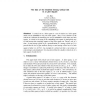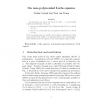JCT
2011
13 years 3 months ago
2011
Abstract. Norton and Stein associated a number with each idempotent quasigroup or diagonalized Latin square of given finite order n, showing that it is congruent mod 2 to the tria...
DM
2011
13 years 4 months ago
2011
A k-plex of a latin square is a collection of cells representing each row, column, and symbol precisely k times. The classic case of k = 1 is more commonly known as a transversal....
ARSCOM
1999
14 years 3 days ago
1999
A critical set in a latin square is a set of entries in a latin square which can be embedded in only one latin square. Also, if any element of the critical set is deleted, the rema...
ALGORITHMICA
1999
14 years 3 days ago
1999
In this paper, we consider the following question: what is the maximum number of entries that can be added to a partially lled latin square? The decision version of this question ...
DCC
2004
IEEE
15 years 1 days ago
2004
IEEE
A Latin square L = L( ij) over the set S = {0, 1, . . . , n - 1} is called totally non-polynomial over Zn iff


